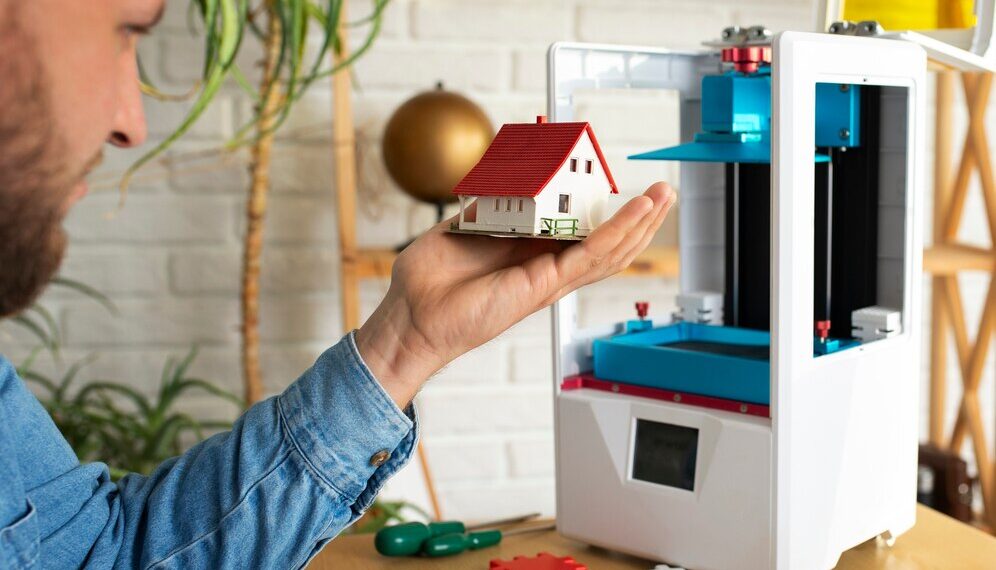Revolutionary Residences: Unleashing the Potential of 3D Printing to Redefine Affordable Housing
The world is currently facing a daunting challenge: the ever-growing global housing crisis. Affordable housing, or the lack thereof, has become a pressing issue affecting millions of people worldwide.
Defined as housing that costs no more than 30% of a household’s income, affordable housing is increasingly out of reach for many individuals and families. The consequences are far-reaching, with a cascade effect on economic stability, social inequality, and overall well-being.
The Global Housing Crisis: A Dire Reality
The global housing crisis is not confined to any particular region or country; it is an issue spanning continents and impacting both developed and developing nations alike. Rapid urbanization, population growth, limited availability of land, and rising construction costs have exacerbated the problem. According to the United Nations (UN), an estimated 1.6 billion people currently lack adequate housing globally.
Innovative Solutions: A Way Forward
To address this urgent challenge, innovative solutions are needed—ones that break away from traditional construction methods and embrace novel approaches to provide affordable homes for all. It is here that 3D printing technology emerges as a beacon of hope for redefining how we approach affordable housing.
Unlocking Potential: The Rise of 3D Printing Technology
While 3D printing has been widely recognized for its transformative potential in various industries—from manufacturing to healthcare—the application of this cutting-edge technology in the realm of construction holds immense promise. By leveraging the precision and efficiency offered by 3D printing technology, it becomes possible to revolutionize the way we build homes and address the global housing crisis head-on.

Understanding 3D Printing Technology
The Fascinating Realm of Additive Manufacturing
At its core, 3D printing, also known as additive manufacturing, is a groundbreaking process that transforms digital designs into tangible objects by depositing materials layer by layer. Originating in the 1980s, this technology has rapidly evolved and extended its reach across diverse industries.
The versatility of 3D printing lies in its ability to create complex geometries and intricate details that traditional manufacturing methods struggle to replicate. From the aerospace and automotive sectors to healthcare and fashion, the applications of 3D printing are virtually limitless.
A Glimpse into the World of Construction
In recent years, the construction industry has witnessed a burgeoning interest in utilizing 3D printing for building homes and structures. This innovative approach involves using specialized printers capable of fabricating entire buildings or components thereof, such as walls or trusses.
Various types of 3D printers are employed in construction projects, including gantry systems that move along rails or robotic arms manipulated by computer algorithms. These machines can incorporate an array of construction-grade materials, such as concrete, clay-based composites, or even recycled plastics.
Advantages of Embracing Revolutionary Construction Techniques
Cutting-Edge Technology that Saves Green
In terms of cost-effectiveness, 3D printing presents compelling advantages over conventional construction methods. By precisely allocating materials during the additive process, there is significantly less waste compared to traditional techniques, where excess is often discarded.
Moreover, automation plays a pivotal role in reducing labour costs since complex tasks can be performed by the printer itself with minimal human intervention. These factors, combined, contribute to considerable savings throughout the construction process.
A Swift Pathway Towards Completion
One striking benefit offered by 3D printing technology is its remarkable speed in constructing buildings. Compared to traditional practices that span months or even years, 3D printers can fabricate structures at an accelerated pace.
The layer-by-layer approach allows for rapid production, with some projects boasting the ability to erect an entire house in a matter of days. This rapid turnaround is particularly advantageous in emergencies or post-disaster scenarios where swift housing solutions are urgently needed.
Personalization: A Paradigm Shift in Housing Design
Customization is an area where 3D printing truly shines, opening up new horizons for architectural design and individualized homes. With this technology, housing can move beyond standardized templates and embrace tailor-made designs that cater to specific needs and preferences. The flexibility of 3D printing allows for the creation of diverse architectural styles, enabling architects and homeowners to explore innovative shapes and structures that were previously challenging to realize through traditional construction methods.
Ultimately, this empowers individuals to have a greater say in how their homes are crafted.

The Current State of Affordable Housing
Statistics on the shortage of affordable housing worldwide
In today’s world, the scarcity of affordable housing has become a pressing global concern. According to the United Nations, an estimated 1.6 billion people, which is approximately 22% of the world’s population, live in inadequate housing or are homeless. Additionally, the Global Housing Affordability Index reveals that in major cities across different continents, housing affordability has reached alarming levels.
In places like Hong Kong and San Francisco, for instance, it is not uncommon for people to spend more than half of their income on rent or mortgage payments. These statistics highlight the urgent need for innovative solutions to address and redefine affordable housing.
Challenges faced by traditional construction methods in delivering affordable homes
Traditional construction methods have long struggled to meet the demand for affordable homes due to various challenges encountered throughout the process. Firstly, labour costs significantly impact affordability, as skilled workers are required at every stage of construction, and their wages can inflate project expenses.
Secondly, material costs continue to rise, making it difficult to maintain budget constraints while ensuring quality standards. Moreover, bureaucratic red tape adds layers of complexity through building permits and regulations that increase both time and cost burdens on developers aiming to provide affordable housing.
Existing attempts to address the issue using prefabrication techniques
Recognizing these challenges, many have turned toward prefabrication techniques as a means to alleviate some of these constraints and enhance efficiency in constructing affordable homes. Prefabrication involves manufacturing components off-site under controlled conditions before assembling them on-site later—a departure from traditional brick-and-mortar approaches.
This method allows for improved cost control since most materials can be purchased in bulk at reduced rates due to economies of scale. Additionally, a shorter construction period is achievable because prefabricated elements can be rapidly assembled on-site, reducing labour requirements.
While prefabrication has shown promise in addressing affordability concerns, it is not without limitations, primarily related to design constraints and limited architectural options. Nonetheless, it represents a step toward more innovative approaches in the realm of affordable housing delivery.
Overall, these statistics shed light on the severity of the affordable housing crisis globally. Traditional construction methods have struggled to keep pace with demand while staying within budgetary limits.
Nonetheless, attempts to incorporate prefabrication techniques have shown potential for providing more cost-effective solutions. To truly redefine affordable housing and tackle this crisis head-on, however, we must explore even more groundbreaking technologies, such as 3D printing, that hold immense promise for revolutionizing the construction industry.
The Potential Impact of 3D Printing on Affordable Housing
Cost-effectiveness: Reinventing Construction Economics
When it comes to addressing the affordability crisis in housing, 3D printing technology has the potential to revolutionize construction economics. One of the key advantages lies in its ability to significantly reduce construction costs.
By harnessing precise material allocation, 3D printers can minimize waste to an unprecedented degree. Traditional construction often incurs substantial material losses due to human error or inefficiencies.
However, with 3D printing, every bit of material is carefully calculated and utilized, resulting in cost savings that can be channelled into providing more affordable homes. Furthermore, the automation inherent in 3D printing leads to reduced labour costs.
The construction industry traditionally relies on manual labour for various tasks, which can be expensive and time-consuming. In contrast, 3D printers operate with minimal human intervention once programmed correctly.
This automation reduces the reliance on a large workforce and lowers overall labour expenses significantly. The cost-effectiveness of 3D printing technology has immense potential to make affordable housing more attainable for lower-income individuals and families.
Speed: Reimagining Construction Timelines
Time is of the essence when it comes to addressing housing crises promptly, especially during emergencies or post-disaster reconstruction efforts. Herein lies another tremendous advantage offered by 3D printing: its ability to dramatically accelerate the construction process.
Compared to traditional methods that involve time-consuming sequential processes such as building foundations, erecting walls, and installing fixtures one step at a time, 3D printing allows for rapid production from start to finish. Layer by layer, a dwelling can take shape within hours instead of weeks or months required through conventional methods.
This heightened speed not only facilitates faster response times during emergencies but also enables quicker delivery of affordable housing units where they are urgently needed. Such efficiency can have a profound impact on communities facing housing shortages, providing a glimmer of hope and stability in times of dire need.
Customization: Empowering Individuality in Housing Design
In the realm of affordable housing, one size does not fit all. Each individual or family has unique needs, preferences, and circumstances that demand personalized solutions.
This is where 3D printing truly shines—it allows for tailored designs and individualized homes. The design flexibility offered by 3D printing technology opens doors to a multitude of architectural styles that can be adapted to suit diverse environments and cultural contexts.
From sleek urban high-rises to cosy suburban dwellings or even eco-friendly structures with intricate organic shapes, the possibilities are limitless. Moreover, 3D printing enables customization based on specific requirements.
Whether it’s accommodating accessibility features for individuals with disabilities or incorporating space-saving solutions for compact urban living, this technology empowers architects and designers to create spaces that align precisely with their occupants’ needs. With customizable designs at their fingertips, governments and housing organizations can cater to various demographics more efficiently.
By ensuring that each home suits its occupants’ unique circumstances, 3D printing helps foster a sense of belonging and empowerment within communities while simultaneously meeting the demands for affordable housing. By harnessing cost-effectiveness, speed, and customization capabilities, 3D printing technology has the potential to redefine how we approach affordable housing challenges.
Embracing this innovative construction method can pave the way towards more efficient utilization of resources while offering tailored solutions that prioritize individuality without compromising affordability. As we delve further into the implications of implementing this transformative technology on a larger scale, it becomes increasingly clear that an era of redefined affordable housing is within our grasp—an era where no one is left without a place they call home.
Challenges and Limitations of Implementing 3D Printed Affordable Housing
Technical challenges: Overcoming limitations related to scale, structural integrity, etc.
Implementing 3D printed affordable housing comes with its own set of technical challenges. One major concern is the scalability of 3D printing technology.
While it has shown promise in constructing small-scale structures, scaling up to larger projects can be a complex task. Engineers and architects need to develop innovative approaches to overcome the limitations related to size and ensure that the structural integrity of the buildings is not compromised.
Additionally, as 3D printing techniques evolve, finding the right balance between speed and quality becomes crucial. Achieving a balance that allows for both efficient construction and durable homes requires continuous research and development.
Regulatory hurdles: Addressing building codes, permits, and legal requirements
Integrating 3D printed affordable housing into existing regulatory frameworks presents another challenge. Building codes, permits, and legal requirements have traditionally been designed for conventional construction methods.
Adapting these regulations to accommodate the unique characteristics of 3D printing technology can be a complex process that involves collaboration among policymakers, industry experts, and regulatory bodies. Ensuring compliance with safety standards while embracing innovative construction techniques is essential in gaining acceptance for these new methods within established systems.
Conclusion
The potential of 3D printing technology to redefine affordable housing is undeniable. Despite facing certain challenges in terms of technical scalability and regulatory adaptation, there is immense optimism surrounding its implementation on a larger scale. By overcoming these obstacles through ongoing research and development collaboration between industry professionals and policymakers alike, we can pave the way for an exciting future where affordable housing crises are alleviated through cutting-edge solutions like 3D-printed homes.
With continued advancements in this field coupled with collective efforts from various stakeholders worldwide—governments, NGOs, and construction companies—we can envision a future where safe, sustainable, and affordable housing is within reach for all. This transformative technology offers hope for an improved quality of life, ensuring that everyone has access to a place they can call home.



